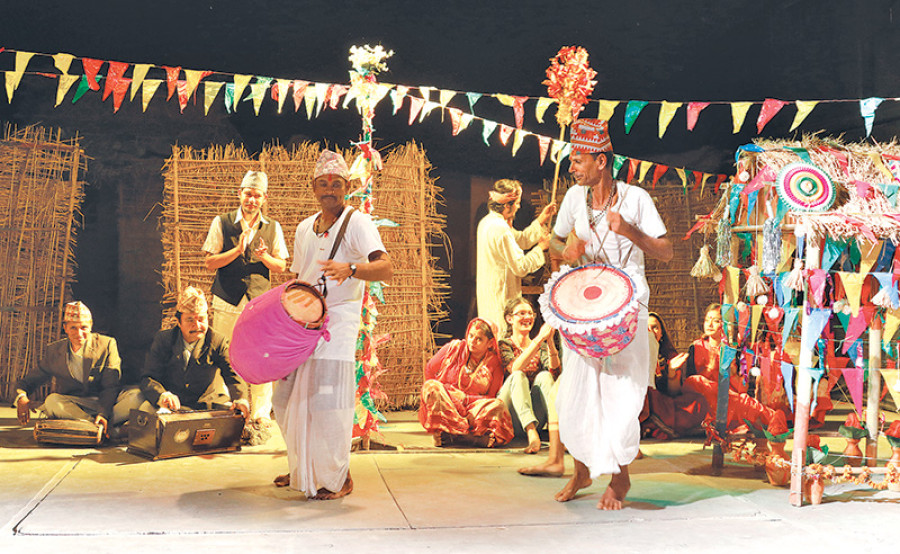Miscellaneous
Flogging a dead horse
What space do the historically deprived, culturally marginalised communities occupy in Nepali society, where individual life and cultural practices are being sacrificed at the altar of the privileged? This is the question that the latest string of plays in Kathmandu’s bourgeoning theatre scene is trying to explore, as they wrestle with the question themselves.
Sandesh Ghimire
What space do the historically deprived, culturally marginalised communities occupy in Nepali society, where individual life and cultural practices are being sacrificed at the altar of the privileged? This is the question that the latest string of plays in Kathmandu’s bourgeoning theatre scene is trying to explore, as they wrestle with the question themselves. Mandala Theatre’s ongoing staging of Laati ko Chhoro, which explores the lives of the voiceless in the marginalised community of the Tarai region, proves that a theatre production can impart moral stories while also enhancing storytelling techniques and fostering artistic value in an empty space.

But Shilpee theatre’s latest staging, Ghodchadi, which shares several similarities with Laati ko Choro, seems to be lost in the entanglement of its own drapery.
Ghodchadi tells the story of life and struggles of Chamar community, where shoe cobbling and Ghodchadi—a game played by dancing with a puppet horse— are the inherited means of livelihood. The play opens as Bauka, a dumb man with a limped leg, is cobbling shoes while his sister-in-law is sourly complaining about how Budhani, the only unmarried daughter in the family, has not yet agreed to tie the knot. Then, Rabi, Budhani’s brother, walks in to give us more information about Budhani: She is 24, has a Master’s degree, lives in the Baazar area alone, and is dexterously organising a Mela to preserve the local culture and heritage—in short, a daughter to the entire village. The topic of Budhani’s marriage is stressed and is given a lot of stage time: it is the only topic of conversation at Bauka’s hearth and there is even a brawl among the village ladies concerning Budhani’s moral character. Thirty minutes into the play, one becomes certain that Budhani’s struggle with her family will be the central conflict in the play. So, it is a grave disappointment when Budhani readily agrees to marry the person chosen by her family.
And, there is the dying Bagatram, Bauka’s elder brother, the horse puppeteer, who is concerned that his profession will die with him. Bagatram has a fight with his son, Rabi, where the latter asks his father to quit his profession for he thinks that it is shameful to dance with a puppet. Rabi is decisively against the tradition and so it is a shock when Rabi, in the final scene, comes on stage as a puppet dancer. We never know what caused a sudden change in the heart in a rebellious teenager.
In between Budhani’s impending marriage conflict, for which the stage has been ripely set but which, sadly, never takes place, and Bagatram’s concern for his dying profession; there is a thief that taunts the villagers, a man who is always drunk because his son has moved to the middle-east, and a mini conversation between a villager and a newly-wed about how it is inappropriate for a married woman to continue her education—little vignettes, which do not serve the story but seem to be accurate portrayal of village life, and this is where writer/director Subhal Mani Sapkota falls short. It seems that the writer wrote the play with drudgery. After all, one easily associates culture with a certain sense of duty: accurate costumes, and long Neta-like speeches which are neither refreshing, like ordinary talk nor defiantly histrionic.
Good theatre is not a presentation but a representation of life. Stage is an empty space, where good theatre can only happen if the script allows the actor to have a communion with the stage, causing the audience to have a spiritual yearning. What we get with Ghodchadi is a kind of pandemonium that is available in the streets of Kathmandu: throughout the play, traditional Chamar instruments are beaten in the background, making it difficult for the dialogue to be completely audible and in the final scene almost twenty people are crammed onto the stage. Every actor is doing something, and music is played, continuously, prompting a sensory overload. The play is as unfocused as any of the Bollywood flicks that are made solely for commercial purposes.
At its best, Ghodchadi is a lively example of Deadly theatre. By offering cheap gimmicks, and antiquated jokes, deadly theatre fosters only consumerism. Theatre is an interactive art, where the audience is equally invested as the actor, and the audience is transformed from the experience as much as the people on stage. Deadly theatre poses the risk of creating a passive audience; a kind of audience who is not aware of the difference between watching a commercial cinema and going to a theatre.
Theatre scene is growing in Nepal; today, there are more theatre groups and more production than ever. It is important for writers and directors to put out socially conscious plays but it is equally important to have productions which have a deep seated reverence and understanding of the art form.
Ghodchadi is currently being staged at Shilpee Theatre in Battisputali, every day at 5:15; the staging will continue through Sept 18.




 17.12°C Kathmandu
17.12°C Kathmandu










